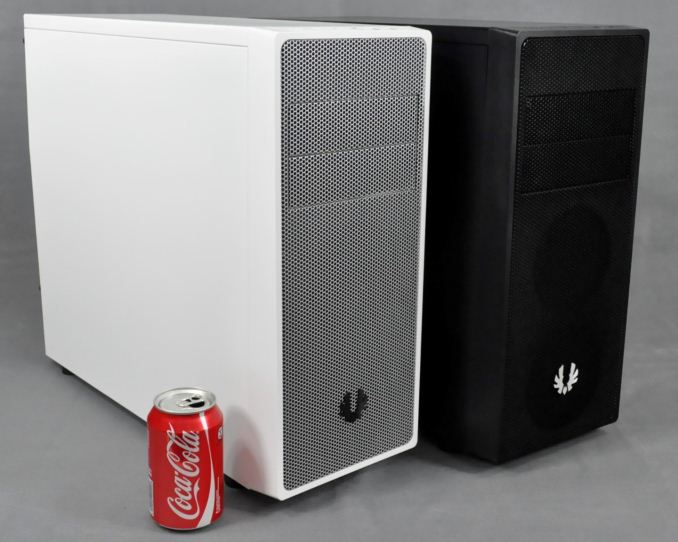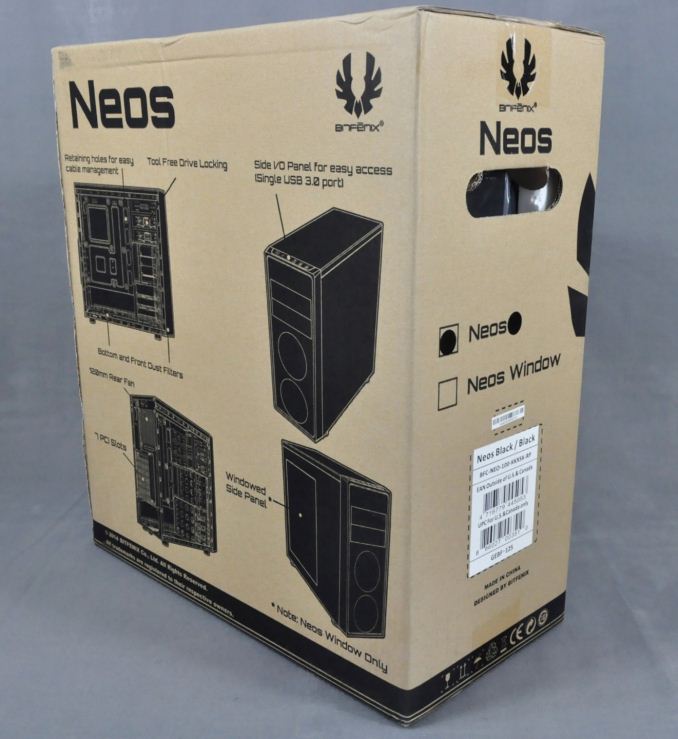BitFenix Neos Case Review
by E. Fylladitakis on January 21, 2015 9:00 AM EST- Posted in
- Cases/Cooling/PSUs
- bitfenix
- Case

Introduction
Naturally, most manufacturers are inclined to have their best products reviewed, as a high-cost product is less likely to have many flaws and it's easy to leave the average user awestruck, promoting the company name. However, the bulk of the revenue of most companies comes from their "mainstream" products, where the target market is many times larger than that of enthusiasts and highly advanced users. In the past several months, we've had the chance to have a look at several advanced cases, some designed for performance while others were meant for special applications. Today we are going to have a look at a standard Mid-ATX case with a price tag of about $60, the BitFenix Neos.
BitFenix is no stranger to AnandTech. Many of their products have been through our labs, from the $39 Merc Alpha to the $159 Shinobi XL, each with its own target group, strengths, and weaknesses. The BitFenix Neos that we are reviewing today aims to be an affordable, simple, and stylish case. It can be found selling from about $50 to $75, depending on the color configuration. Two chassis are available, either black or white, but there is a large selection of faceplate/mesh colors for either chassis, including black, white, red, bronze, silver, gold, blue, and purple.
12 oz. Coke can for size comparison.
| >BitFenix Neos Specifications | ||
| Motherboard Form Factor | ATX, Micro-ATX, Mini-ITX | |
| Drive Bays | External | 2 x 5.25" |
| Internal | 3 x 3.5" (front drive cage) 3 x 2.5" (front drive cage) | |
| Cooling | Front | 2 x 120 mm (optional) |
| Rear | 1 x 120 mm (included) | |
| Top | - | |
| Left Side | - | |
| Bottom | - | |
| Radiator Support | Front | - |
| Rear | 120 mm | |
| Top | - | |
| Side | - | |
| Bottom | - | |
| I/O Port | 1x USB 3.0, 1x USB 2.0, 1x Headphone, 1x Mic | |
| Power Supply Size | ATX | |
| Clearances | HSF | 155 mm |
| PSU | - | |
| GPU | 310 mm | |
| Dimensions | 429 mm × 185 mm × 470 mm (H×W×D) 16.89 in × 7.28 in × 18.5 in (H×W×D) | |
| Prominent Features | Front Dust Filter PSU Dust Filter Tool-Free Drive Locking | |
| Price | $50 to $75, depending on the color configuration | |
Packaging and Bundle
BitFenix supplies the Neos in colorless, brown cardboard boxes. Illustrations on the box depict the most important features of the case. Inside the box, the lightweight case is very well protected by thick styrofoam slabs and a nylon bag. As for the bundle, we are not going to delve much into it, simply because there is virtually nothing noteworthy supplied with the Neos. With the purchase of this case, the user will only receive a basic manual and the necessary screws in a small nylon bag.












54 Comments
View All Comments
maecenas - Wednesday, January 21, 2015 - link
Wow, probably the most searing Anandtech review I've seen. Thank you for your honesty, I'll steer clear of this product....nathanddrews - Wednesday, January 21, 2015 - link
The first thing I thought was "are you sure your components are operating properly?" The results are outstanding, for sure. My personal experience with cases has been to either buy the most basic, affordable POS with its own PSU or go big and spend extra to get something really nice. There's not much in between.sfuzzz - Wednesday, January 21, 2015 - link
Well, it's not completely true. For example, The CM N200 is a good microATX case (decent aestetics too, however it's subjective) that costs half the case in this review and can handle pretty powerful systems on air and liquid.drainplugofideas - Wednesday, January 21, 2015 - link
I have that case! I really like it overall.Samus - Wednesday, January 21, 2015 - link
I tried a Bitfenix Prodigy ITX about a year ago, and the case was simply awful. It weighed a ton, the panels were unnecessarily heavy, which directly correlated to poor thermals. It was like an oven inside, even with a 200mm intake and 120mm exhaust fan. The memory modules were too hot to touch. The 200mm fan was useless...even after replacing it with a coolermaster fan, it was apparent the problem was the air holes for the fan. There were 6 of them, and they are dime-sized. The intake system was starved. The appearance of these cases leads you to believe they are well designed, when in fact they are just a crap covered in glitter. The icing on the cake is the price. They are twice as expensive as competing models from Coolermaster, Antec, and Corsair, companies vastly more experienced in case manufacturing and design.Stay away from Bitfenix. If you're going to spend this level of money on something, get a "real" case from Lian Li, Silverstone, or a high end product from another established manufacture.
Gigaplex - Wednesday, January 21, 2015 - link
"I tried a Bitfenix Prodigy ITX about a year ago, and the case was simply awful. It weighed a ton, the panels were unnecessarily heavy"I have a Prodigy, and I agree, it's heavy for its size.
"which directly correlated to poor thermals"
It sounds like you got a model with the solid faceplate. The mesh faceplate models give excellent thermal performance, and I have no issues with mine. Even the AnandTech review of it gave it an Editors Choice award. The fact that the panels are heavy don't contribute to poor thermal performance.
Alexvrb - Thursday, January 22, 2015 - link
While not as good at conducting heat as aluminum, steel isn't really an insulator so I doubt having a little thicker panels is going to trash cooling performance. I've used some really stout cases, including oldschool Lian Li cases that were built out of what seemed like 1/4" thick steel. They worked great even though they had panels that were "unnecessarily heavy". Airflow is much more important and it sounds like the particular model you bought suffered from poor airflow. Based on what I've seen and heard it would Bitfenix has at least some good models out there. Also Coolermaster makes a variety of fans and depending on the model it may not push significantly more air especially in a restrictive case (perhaps due to poor static pressure - if they don't publish this number it probably isn't very good).SleepModezZ - Wednesday, January 21, 2015 - link
Currently on Amazon the N200 is around $50 - as is the cheapest Neos. So not half the price. In Finland where I shop the N200 will cost a bit more than the Neos. Seems like a nice case and better for a gaming system but it is for a microATX board unlike the Neos that takes a full size ATX board. The Neos also has place for two 5.25 drives and not just one. (I don't think that many needs two optical drives but the 5.25 place could be used for something else. I usually have my 3.5 HDDs put into the 5.25 places to eliminate the amplification of vibration and seek noises by the case.)Samus - Wednesday, January 21, 2015 - link
There is no debate about it. Bitfenix makes crap. Anybody who says otherwise either hasn't touched one of their piece of crap products, or unfortunately owns one and is in the deeper stages of denial but will eventually reach acceptance that they do in fact own a piece of crap.There are various Corsair and Coolermaster cases that may not be that much cheaper ($30-$40 such as the Elite 110, Elite 361 and the Corsair Carbide Spec-01) and not much of a looker, but are significantly better at actual cooling.
I've had Rosewill cases that cost $20 and actually work, in that they house and cool components properly. Bitfenix is basically picking up old SECC tooling equipment on the cheap, hiring flunkie engineers to design what looks good, and selling them for bottom-dollar prices based on looks, not functionality or performance.
hughlle - Wednesday, January 21, 2015 - link
Unfortunately your opinion is completely and utterly contradicted by almost every review on the internet. So clearly there is a debate about it.